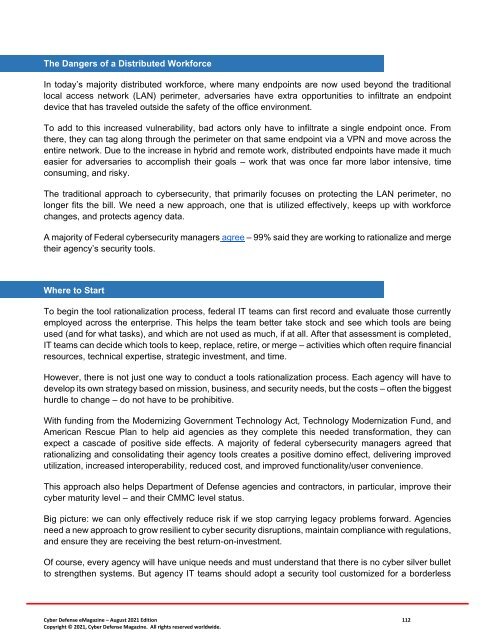Cyber Defense eMagazine August Edition for 2021
Cyber Defense eMagazine August Edition for 2021 #CDM #CYBERDEFENSEMAG @CyberDefenseMag by @Miliefsky a world-renowned cyber security expert and the Publisher of Cyber Defense Magazine as part of the Cyber Defense Media Group as well as Yan Ross, US Editor-in-Chief, Pieruligi Paganini, Co-founder & International Editor-in-Chief, Stevin Miliefsky, President and many more writers, partners and supporters who make this an awesome publication! Thank you all and to our readers! OSINT ROCKS! #CDM #CDMG #OSINT #CYBERSECURITY #INFOSEC #BEST #PRACTICES #TIPS #TECHNIQUES
Cyber Defense eMagazine August Edition for 2021 #CDM #CYBERDEFENSEMAG @CyberDefenseMag by @Miliefsky a world-renowned cyber security expert and the Publisher of Cyber Defense Magazine as part of the Cyber Defense Media Group as well as Yan Ross, US Editor-in-Chief, Pieruligi Paganini, Co-founder & International Editor-in-Chief, Stevin Miliefsky, President and many more writers, partners and supporters who make this an awesome publication! Thank you all and to our readers! OSINT ROCKS! #CDM #CDMG #OSINT #CYBERSECURITY #INFOSEC #BEST #PRACTICES #TIPS #TECHNIQUES
Create successful ePaper yourself
Turn your PDF publications into a flip-book with our unique Google optimized e-Paper software.
The Dangers of a Distributed Work<strong>for</strong>ce<br />
In today’s majority distributed work<strong>for</strong>ce, where many endpoints are now used beyond the traditional<br />
local access network (LAN) perimeter, adversaries have extra opportunities to infiltrate an endpoint<br />
device that has traveled outside the safety of the office environment.<br />
To add to this increased vulnerability, bad actors only have to infiltrate a single endpoint once. From<br />
there, they can tag along through the perimeter on that same endpoint via a VPN and move across the<br />
entire network. Due to the increase in hybrid and remote work, distributed endpoints have made it much<br />
easier <strong>for</strong> adversaries to accomplish their goals – work that was once far more labor intensive, time<br />
consuming, and risky.<br />
The traditional approach to cybersecurity, that primarily focuses on protecting the LAN perimeter, no<br />
longer fits the bill. We need a new approach, one that is utilized effectively, keeps up with work<strong>for</strong>ce<br />
changes, and protects agency data.<br />
A majority of Federal cybersecurity managers agree – 99% said they are working to rationalize and merge<br />
their agency’s security tools.<br />
Where to Start<br />
To begin the tool rationalization process, federal IT teams can first record and evaluate those currently<br />
employed across the enterprise. This helps the team better take stock and see which tools are being<br />
used (and <strong>for</strong> what tasks), and which are not used as much, if at all. After that assessment is completed,<br />
IT teams can decide which tools to keep, replace, retire, or merge – activities which often require financial<br />
resources, technical expertise, strategic investment, and time.<br />
However, there is not just one way to conduct a tools rationalization process. Each agency will have to<br />
develop its own strategy based on mission, business, and security needs, but the costs – often the biggest<br />
hurdle to change – do not have to be prohibitive.<br />
With funding from the Modernizing Government Technology Act, Technology Modernization Fund, and<br />
American Rescue Plan to help aid agencies as they complete this needed trans<strong>for</strong>mation, they can<br />
expect a cascade of positive side effects. A majority of federal cybersecurity managers agreed that<br />
rationalizing and consolidating their agency tools creates a positive domino effect, delivering improved<br />
utilization, increased interoperability, reduced cost, and improved functionality/user convenience.<br />
This approach also helps Department of <strong>Defense</strong> agencies and contractors, in particular, improve their<br />
cyber maturity level – and their CMMC level status.<br />
Big picture: we can only effectively reduce risk if we stop carrying legacy problems <strong>for</strong>ward. Agencies<br />
need a new approach to grow resilient to cyber security disruptions, maintain compliance with regulations,<br />
and ensure they are receiving the best return-on-investment.<br />
Of course, every agency will have unique needs and must understand that there is no cyber silver bullet<br />
to strengthen systems. But agency IT teams should adopt a security tool customized <strong>for</strong> a borderless<br />
<strong>Cyber</strong> <strong>Defense</strong> <strong>eMagazine</strong> – <strong>August</strong> <strong>2021</strong> <strong>Edition</strong> 112<br />
Copyright © <strong>2021</strong>, <strong>Cyber</strong> <strong>Defense</strong> Magazine. All rights reserved worldwide.


















